I Could Tell You But Then You Would Have to be Destroyed by Me: Emblems from the Pentagon's Black World
Search in google:
They’re on the shoulder of all military personnel: patches that symbolize what their unit does. But what if that’s top secret?“A fresh approach to secret government. It shows that these secret programs have their own culture, vocabulary and even sense of humor.”—Steven Aftergood, The Federation of American ScientistsIn a work that combines ingenious journalism and bizarrely encoded art, author/photographer/investigator Trevor Paglen uncovers sixty never-before-seen-in-public military patches that reveal a bizarre secret world of the American military. Paglen investigates classified weapons projects and intelligence operations by examining their own imagery and jargon, disclosing new facts about important classified military units—here known by peculiar names (“Goat Suckers,” “None of Your Fucking Business,” “Tastes Like Chicken”) and illustrated with occult symbols and ridiculous cartoons. The precisely photographed patches—worn by military personnel working on classified missions, such as those at the legendary Area 51—reveal much about a strange and eerie world about which little was previously known.The author has also assembled an extensive and readable guide, based on extensive interviews with military sources and government records, to the patches included here, making this volume perhaps the best available survey of the military's black world—a $27 billion industry that has quietly grown by almost 50 percent since 9/11.The New York Times - Steven Heller…semiofficial patches woven with emblems representing secret American military operations are collected for the first (and maybe the last) time in Trevor Paglen's I Could Tell You But Then You Would Have to be Destroyed by Me: Emblems from the Pentagon's Black World…Military symbols are frequently replete with heraldic imagery—some rooted in history, others based on contemporary popular arts that feature comic characters—but these enigmatic dark-op images, in some cases probably designed by the participants themselves, are more personal, and also more disturbing, than most.








